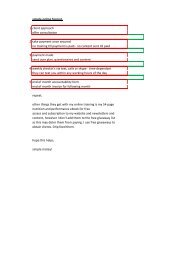You also want an ePaper? Increase the reach of your titles
YUMPU automatically turns print PDFs into web optimized ePapers that Google loves.
The mind muscle connection<br />
*“As you know, movement is controlled by the brain. The first step towards muscular contraction is a<br />
signal sent by the brain to your muscles telling them to contract. You might say that the Mind-Muscle<br />
Connection (MMC) occurs at something called the "neuromuscular junction". This is where the mind<br />
meets the body”<br />
What this means is that when you recruit a muscle to lift a weight your brain will send signals to the<br />
muscle groups needed to lift it. The peripheral nervous system (PNS) will detect the weight, send<br />
signals to the central nervous system (CNS) <strong>and</strong> the brain. Then the body will then recruit the<br />
required muscle fibres needed to lift the weight. The mind muscle connection simple means to<br />
underst<strong>and</strong> what muscle is going to be used <strong>and</strong> focus is presented solely on that muscle or muscle<br />
group to make the lift effective. By doing this you will effectively train that muscle <strong>and</strong> become more<br />
efficient in how your body moves. You will learn much about the human body <strong>and</strong> its capabilities.<br />
Benefits of improving the mind muscle connection:<br />
<br />
<br />
<br />
<br />
Improving your MMC increases the number of muscle fibres being recruited when lifting.<br />
If you're worried about wasting energy on warm up sets, try it on an off day.<br />
You're more aware of your muscles when fully pumped, making it easier to isolate them.<br />
Better self-awareness, this could lead to better stability <strong>and</strong> improvement in body<br />
composition <strong>and</strong> day to day form.<br />
To underst<strong>and</strong> it better we must underst<strong>and</strong> the difference between the primary movers <strong>and</strong> the<br />
secondary movers.<br />
The bench press for instance. The primary mover will be the pectoral muscle <strong>and</strong> the secondary<br />
movers will be the anterior deltoid <strong>and</strong> the triceps. The primary mover is the muscle you want to<br />
isolate, the muscle you want to connect with the mind. So, in this case it’s the pectoral muscle, the<br />
“peck”.<br />
Think of it like you are trying to present the muscle. Present its form to someone, showing it off.<br />
Some tips on how to activate muscles using the mind:<br />
<br />
<br />
<br />
<br />
St<strong>and</strong> on the spot <strong>and</strong> tell yourself what muscle you want to activate. Then squeeze that<br />
muscle. So, for the bicep you would curl the arm up <strong>and</strong> squeeze the muscle on the<br />
contraction. Then use the same implementation with a weight<br />
In-between sets flex the target muscle. This forces additional blood into your muscles <strong>and</strong><br />
help to pump them up further. Why? Because the more the muscle is pumped then the<br />
more aware you are of how to isolate it<br />
Perform a set very slowly. Use a lighter weight <strong>and</strong> concentrate on the contraction phase of<br />
the muscle<br />
When lifting try to present the muscle, as if showing it off to someone when its flexed<br />
So, as you can see if you want to increase your potential in the gym <strong>and</strong> with <strong>performance</strong> you must<br />
get to grips with the underst<strong>and</strong>ing of muscle isolation, contraction <strong>and</strong> tension. I will delve further<br />
into this in the next section.<br />
47




